1930s
The Scarecrow of Tomorrow
Miss Penelope Shoo. A scarecrow with style. On display by the Wonder Bakery exhibit at the 1939 New York World's Fair.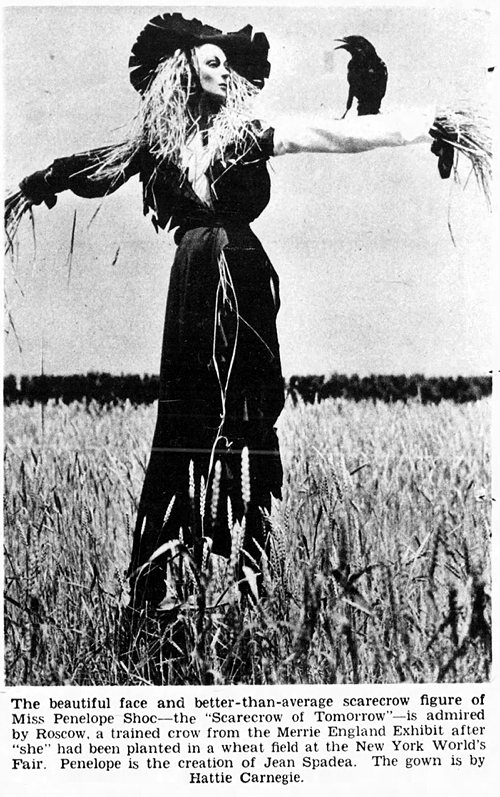
Pittsburgh Press - July 2, 1939
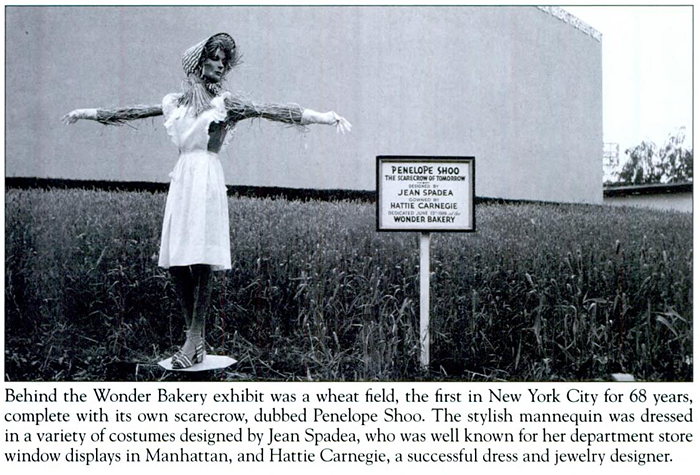
source: The 1939-1940 New York World's Fair, by Bill Cotter
Posted By: Alex - Sat Oct 30, 2021 -
Comments (1)
Category: Fashion, 1930s, Halloween, Yesterday’s Tomorrows
Follies of the Madmen #518
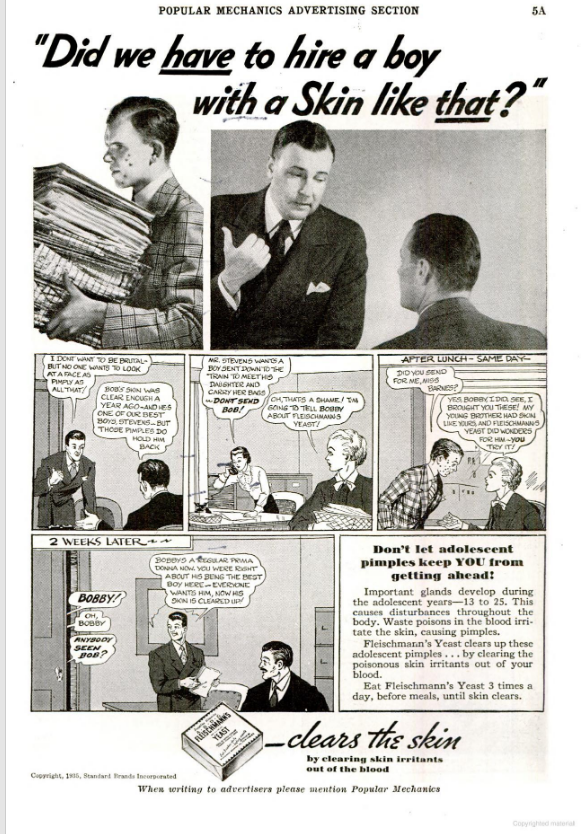
Source.
Posted By: Paul - Wed Oct 27, 2021 -
Comments (0)
Category: Business, Advertising, Hygiene, 1930s, Skin and Skin Conditions
The Girl of the Far Future
This dress wouldn't have been out of place at an awards show in the '80s, or even today. So I'll give Ralph Moni credit for an accurate prediction.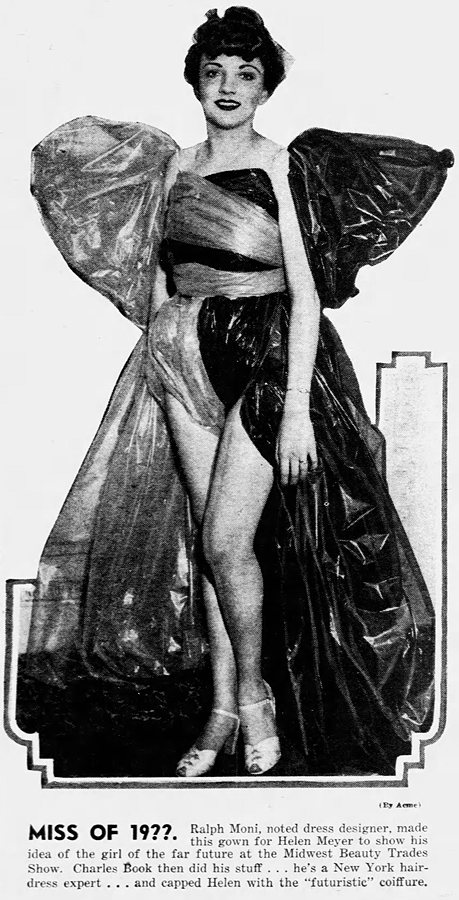
New York Daily News - Mar 10, 1939
Ralph Moni, noted dress designer, made this gown for Helen Meyer to show his idea of the girl of the far future at the Midwest Beauty Trades Show. Charles Book then did his stuff. . . he's a New York hairdress expert. . . and capped Helen with the "futuristic" coiffure.
Posted By: Alex - Mon Oct 25, 2021 -
Comments (1)
Category: Fashion, 1930s, Yesterday’s Tomorrows
Budd-Michelin Rubber-Tire Trains
The Wikipedia page.Long informative article here (a PDF).
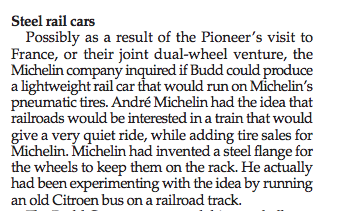
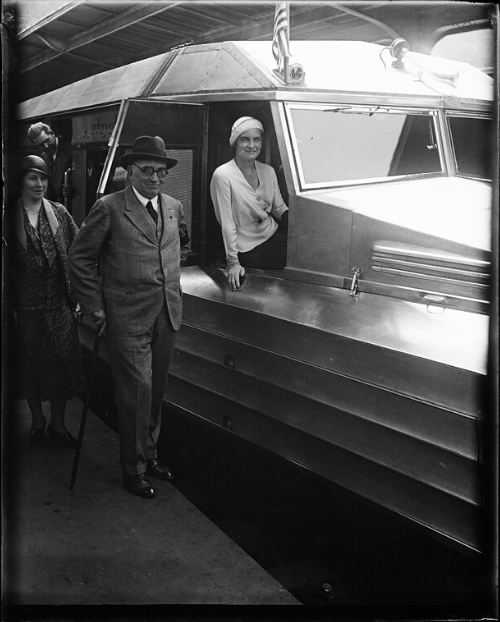
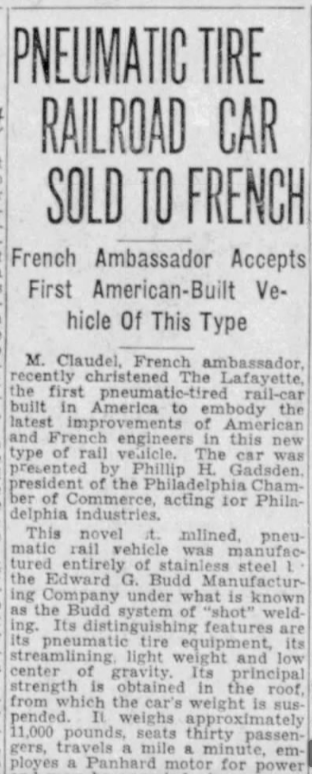
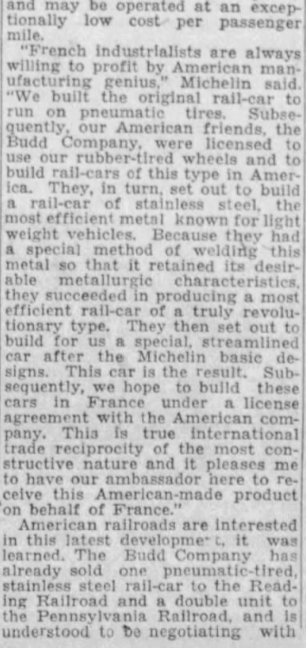
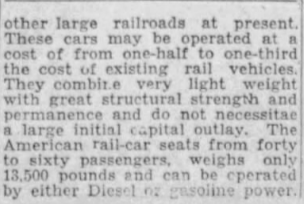
Newspaper source: The Fresno Bee (Fresno, California) 25 May 1932, Wed Page 13
Posted By: Paul - Wed Oct 13, 2021 -
Comments (2)
Category: Inventions, 1930s, Europe, North America, Trains
No dates for speeders
If Aristophanes's Lysistrata was rewritten to be set in Memphis during the 1930s, it could be about all the young women banding together to refuse to date any boys who drove faster than the speed limit.
Pittsburgh Press - Feb 26, 1939
A better quality picture of Mary Agnes:

Posted By: Alex - Sat Oct 09, 2021 -
Comments (2)
Category: Gender, 1930s, Cars
Trapeze Artist Swallows Watch
"About a week ago Miss Nichols missed her watch. Since she occasionally places valuables in her mouth at night for safe keeping, she feared she might have swallowed the timepiece."I'm sure Miss Tarzana Nichols really went to the hospital, but I'd be willing to bet that the reason she went was just a stunt to get her name in the papers. Free publicity for her act.

Kansas City Star - Oct 11, 1934
Posted By: Alex - Thu Oct 07, 2021 -
Comments (4)
Category: Publicity Stunts, 1930s
Underworld Lingo, 1930
Some of these look pretty dubious.Source.
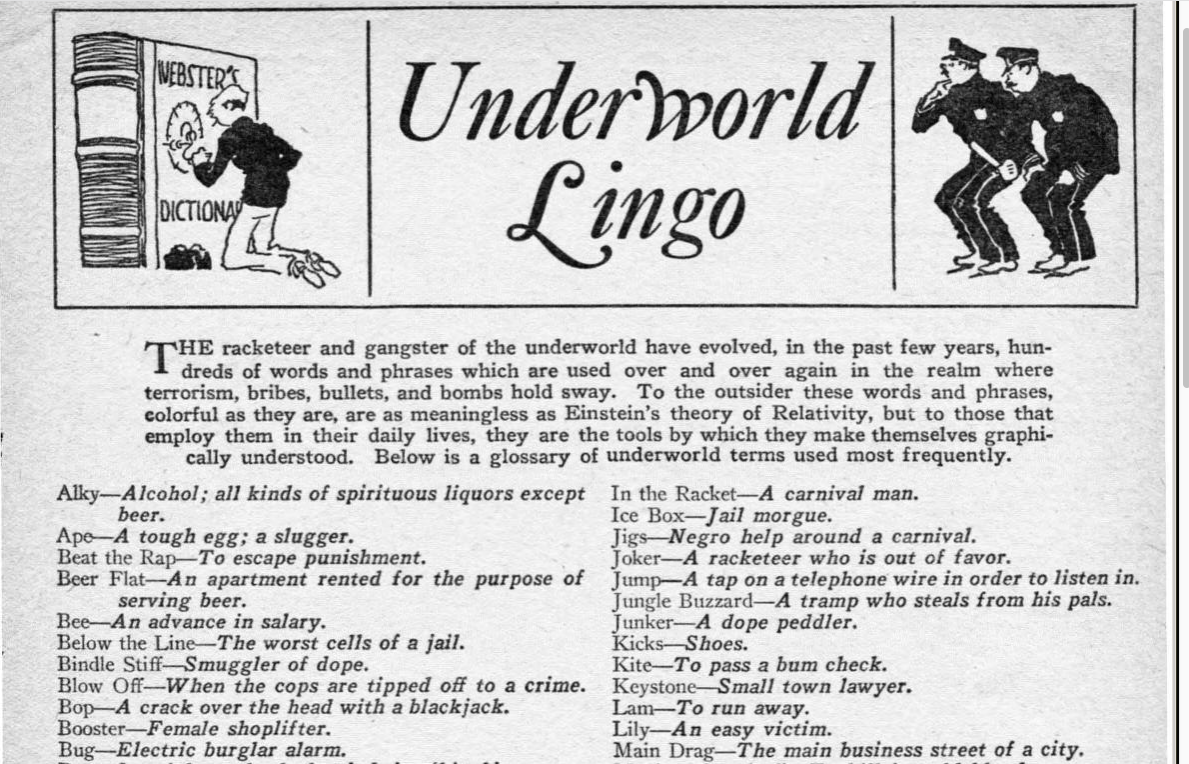
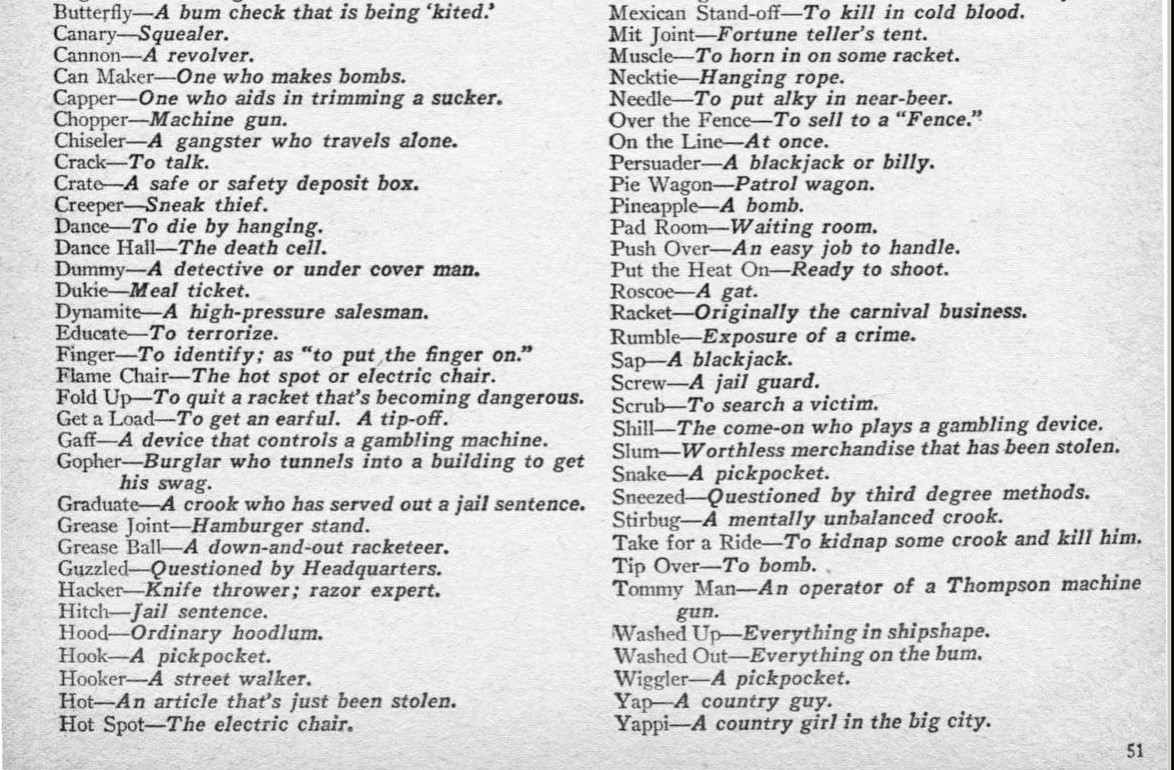
Posted By: Paul - Thu Oct 07, 2021 -
Comments (1)
Category: Crime, Languages, Slang, 1930s
Pine Needle Skiing
Pine needle skiing was introduced in the 1930s in an attempt to make skiing a year-round activity. I don't think it survived long past the 30s. This account of the sport, written by Newton F. Tolman for The Atlantic (Feb 1957 issue), explains why:All known technique was useless. The only way to turn was to jump. You had to fend off the pine trees with your poles. We ended up not only bleeding and bruised, but completely black. Dives into pine needles encrusted everything but our eyeballs with dirt, pitch, and sweat. It really combined two sports - skiing and tar-and-feathering.
The video shows a pine needle ski jump in New Hampshire, 1935:
The images show people skiing at the Pine Needle Ski Slope which opened in Los Angeles in 1939:

source: LA Public Library


source: Vintage LA
Posted By: Alex - Tue Oct 05, 2021 -
Comments (1)
Category: Sports, 1930s
The Gnathograph
The Gnathograph, or 'dental articulator', was the invention of Los Angeles dental surgeon Beverly McCollum. He was also the founder, in 1926, of the Gnathologic Society.The name 'Gnathograph' derived from 'gnathology,' this being the study of the jaw and masticatory system, from the greek word 'gnathos' meaning 'jaw'.

"The formidable contraption shown in the mouth of Miss Pearl Nord is a gnathograph, invented by Dr. Beverly B. McCollum of Los Angeles and demonstrated before the chicago Dental Society. It records direction of bite and fit of teeth and accurately guides a dentist in straightening crooked teeth or fitting inlays, crowns, bridges and plates."
image source: Agi Haines

The band Femur used the image above from Popular Science as the cover art for their album Red Marks.

Posted By: Alex - Sun Oct 03, 2021 -
Comments (0)
Category: Inventions, Patents, 1930s, Teeth
The Tax Centinels
April 1938: Students at Renselaer Polytechnic Institute managed to acquire almost all the pennies in the town of Troy, New York — around 250,000 pennies in total. They did this by first going around store-to-store claiming they needed pennies for a "penny-ante poker game." Then they went to the banks and purchased their entire supply of pennies. Since each bank was unaware that the same thing was occurring at all the other banks, they happily sold the students all the pennies they had.As a result, the town of Troy suddenly discovered that it was in the grip of a "penny famine." Shopkeepers found themselves unable to make change. And more significantly, they found it difficult to charge the state sales tax.
This had been the point of the stunt. It had been organized by a group of students calling themselves the "Tax Centinels" in order to "focus public attention on the taxes which they claim account for 25 per cent of the cost of all necessities of life."
Having cornered all the pennies, the students went into the town the next day and began making purchases, using pennies to pay for one-quarter of whatever the cost of the item was. It was a bit like the time-honored stunt of paying fines with pennies.
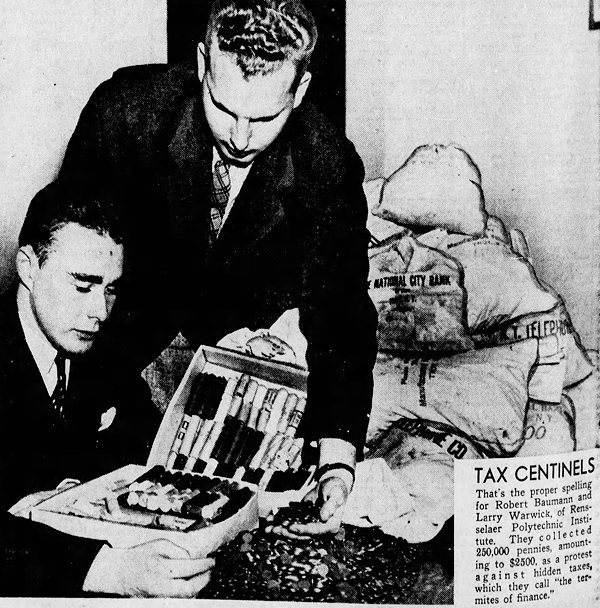
Philadelphia Inquirer - Apr 6, 1938
The movement quickly spread to other colleges, so that other college towns were soon beset by penny famines. New members of the Tax Centinels were required to take the following pledge:
It shall be the purpose of this organization to focus public attention on the evils of the practice of keeping concealed taxes and to awaken in the public consciousness a realization that 70 per cent of all taxes now collected by more than 175,000 separate taxing bodies in the United States are obtained through secret levies tacked on to the price of necessities we all must buy daily—food, clothing, shelter, luxuries, and semi-luxuries.
Since the average man does not realize the inroads made upon his purse by these vicious hidden taxes and that he himself pays the major costs of the government instead of the Rockefellers, Morgans and du Ponts, I hereby pledge myself to pay 25% of the price of all purchases in pennies in order to dramatize the situation to the end that it may be remedied.
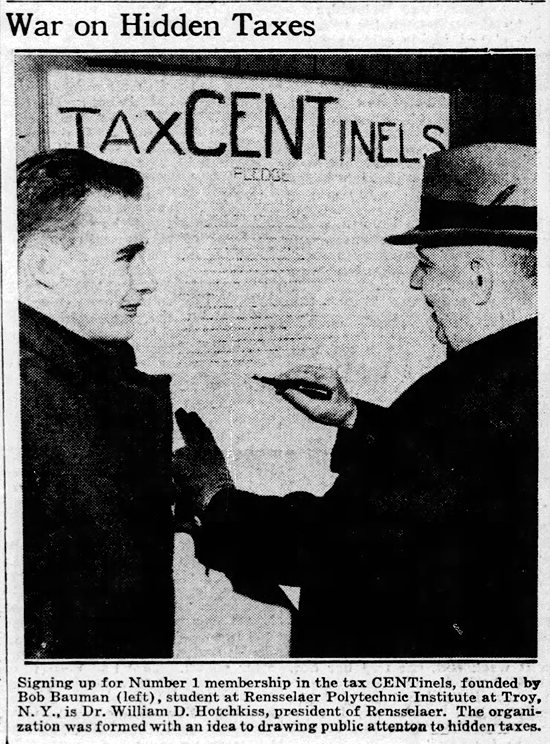
Wisconsin State Journal - Apr 11, 1938
As far as I can tell, the Tax Centinel movement lasted a month or two before fizzling out. But it seems to have been symptomatic of a widespread popular discontent at the time over the sales tax. See, for instance, our earlier post about the guy who in 1939 took a case all the way to the supreme court over his indigation at having been, in his mind, unfairly charged one-half cent of sales tax.
More info: "Tax Centinels," Star and Lamp (Pi Kappa Phi newsletter) - May 3, 1938. Page 4.
Posted By: Alex - Thu Sep 30, 2021 -
Comments (3)
Category: Money, 1930s, Universities, Colleges, Private Schools and Academia, Pranks

| Who We Are |
|---|
| Alex Boese Alex is the creator and curator of the Museum of Hoaxes. He's also the author of various weird, non-fiction, science-themed books such as Elephants on Acid and Psychedelic Apes. Paul Di Filippo Paul has been paid to put weird ideas into fictional form for over thirty years, in his career as a noted science fiction writer. He has recently begun blogging on many curious topics with three fellow writers at The Inferior 4+1. Contact Us |




